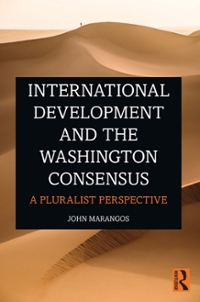Find solutions
Exercise 1.8 (Moderate) World population was about 679 million in the year 1700 and about 954 million in 1800. 1. What was the annual growth rate of population between 1700 and 1800? (Use con- tinuous compounding.) 2. Suppose that the human race began with Adam and Eve and that the annual growth rate between 1700 and 1800 prevailed in all years prior to 1700. About when must it have been that Adam and Eve were evicted from the Garden of Eden? (Hint: What was the population in that year?) Exercise 1.9 (Moderate) According to figures compiled by the World Bank, per capita real income in the U.S. was $15,400 in 1984, while the corresponding figure for Japan was $10,600. Between 1965 and 1984, per capita real income in the U.S. grew at an annual rate of 1.7 percent (using annual compounding), while the corresponding figure for Japan was 4.7 percent. 1. If these two growth rates remain constant at their 1965-84 levels, in what year will per capita real income be the same in these two countries? (Again, use annual com- pounding, and use hundredths of a year.) 2. What will be the common per capita real income of these two countries at that date?Exercise 1.1 (Easy) My credit card has an APR (annualized percentage rate) of 16.8%. What is the daily interest rate? Exercise 1.2 (Easy) My loan shark is asking for $25 in interest for a one-week loan of $1,000. What is that, as an annual interest rate? (Use 52 weeks per year.) Exercise 1.3 (Moderate) The Consumer Price Index (CPI) is a measure of the prices of goods that people buy. Bigger numbers for the index mean that things are more expensive. Here are the CPI numbers for four months of 1996 and 1997: Preliminaries Variable Definition Principal (amount invested) Nominal interest rate Number of years invested V,In Value after n years under simple interest V.(n) Value after n years under annual compounding Vi(n) Value after n years when compounded : times per year Ve(n Value after n years under continuous compound- ing Vo Initial value of the investment Table 1.1: Notation for Chapter 1 Year Mar Jun Sep Dec 1996 155.7 156.7 157.8 158.6 1997 160.0 160.3 161.2 161.3 What is the growth rate of the CPI between June 1996 and September 1996? (Use a contin- uous growth rate and annualize your answer.) Exercise 1.4 (Moderate) Use the CPI data from the previous exercise to compute the growth rates in the CPI in the four quarters starting in March 1996 (i.e, Mar-Jun 1996, Jun-Sep 1996, etc.). (Use a continuous growth rate but do not annualize your answer.) Show that the sum of these four rates equals the (continuous) growth rate from March 1996 to March 1997. Exercise 1.5 (Easy) Real output of the United States will likely grow by about 2% over the first half of the next century. At that rate (of continuous growth), how long will it take for real output to double? Compare your exact answer with the approximation given by the "Rule of 72."2 Exercise 1.6 (Hard) This morning you invest $10,000 at 6.5% interest that compounds annually. What is the first date on which you would have at least $15,000? (Quote the answer in terms of years + days from today. Interest accrues each night, but compounds only annually.) Exercise 1.7 (Easy) Suppose that 4.6 percent of the earth's forests are cleared each year. How long will it take "The "Rule of 72" is as follows. If the interest rate on an investment is z percent, then it takes about 72/z years for the value of the investment to double








